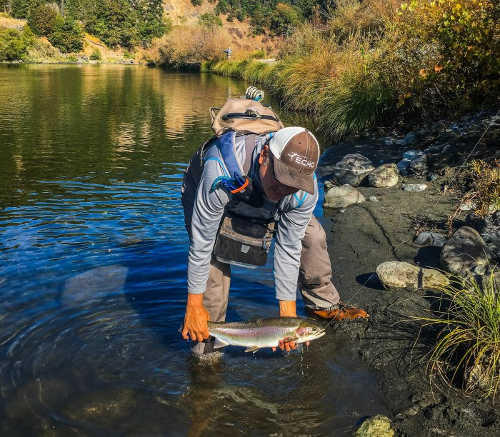
Rainbow trout/steelhead vs coastal cutthroat trout, eating fresh-caught fish at sea,
Question: I have a question regarding regulations on non-adipose fin-clipped (“wild”) rainbow trout/steelhead and coastal cutthroat trout in tributaries on the North Coast (e.g. the lagoons in northern Humboldt County).
Anglers are not permitted to keep wild rainbow trout/steelhead but are permitted to keep wild coastal cutthroat trout. However, these two species are well known to hybridize and hybrid offspring are reproductively viable.
Hybrids also exhibit a continuous spectrum of phenotypic expression that runs from the rainbow phenotype (few spots below the lateral line, small head, maxillary terminating before the rear of the eye and no throat slashes) to the cutthroat phenotype (heavily spotted including below the lateral line, large head, maxillary extending past the rear of the eye and throat slashes present).
These phenotypes are what the California Department of Fish and Wildlife (CDFW) website recommends for identification of the two species, but there is no reference to the basibranchial teeth that are specific to cutthroat.
Therefore, if an angler catches a non-adipose fin-clipped trout that has no throat slashes, no spots below the lateral line, a small head and a maxillary that does not extend beyond the rear of the eye, but has basibranchial teeth, is the angler allowed to keep the trout? The fish described is likely a hybrid “cuttbow.”
Alternatively, if an angler catches a trout that outwardly looks like a coastal cutthroat but does not have basibranchial teeth, is the angler allowed to keep the trout?
Again, this fish is likely a cuttbow. (Brian P., Sacramento)
Answer: According to CDFW Environmental Program Manager Roger Bloom, it is true that rainbow trout/coastal cutthroat hybrids exist at some low level in sympatric populations.
However, based on a recent scientific study, the practice of using phenotypic traits to distinguish hybrids is not very effective.
Although the presence of basibranchial teeth are a strong indication of a cutthroat trout lineage, it should not be used exclusively as a definitive sign to retain/harvest a fish.
From a regulatory/enforcement perspective, field identification of coastal cutthroats should be based on commonly agreed upon morphology of red/orange slashes found under the jaw.
If there is a question about a fish being a hybrid coastal cutthroat crossed with a rainbow trout, anglers should err on the side of caution. It must have observable red/orange slashes if the trout is to be considered a coastal cutthroat for harvest.
Interestingly, some Central Valley hatchery steelhead may exhibit orange/yellow slashes which could stem from genetic influences via ancestral redband trout.
Hence, if an angler encounters an adipose-clipped fish that looks like a rainbow trout but has these characteristics, it can be retained/harvested as there are currently no hatchery coastal cutthroats with clipped adipose fins.
Eating fresh-caught fish while at sea?
Question: Is it legal to eat just-caught fish while still at sea? For example, if I catch a tuna, fillet it into six pieces and later that day have one piece for dinner, would that be a criminal offense under the new fillet rules? (Jim K.)
Answer: No, you are welcome to cook sport-caught fish on a vessel as long as the fish is counted toward the angler’s individual bag limit and the vessel’s boat limit.
The fish must also meet the fillet length requirements and any skin patches must be left on until the fish is prepared for immediate consumption (Fish and Game Code, sections 5508 and 5509). This applies regardless of which species is taken, and includes the new tuna fillet rules.
Remember, you cannot catch another fish to replace the one that has been eaten once the bag/boat limit has been filled for that type of fish for that day.
Ranching wild pigs on private property?
Question: Are there circumstances under which a California rancher or even a private resident can keep live wild pigs on their property? I haven’t found any regulations that specifically address this. (Mike A.)
Answer: No, it is not lawful for any California resident to possess wild pigs (Sus scrofa) (California Code of Regulations Title 14, section 671(c)(2)(Q)). However, there is an exception for Sus scrofa domestica, also known as the domesticated pig one commonly sees on a farm (CCR Title 14, section 671(c)(2)(Q)(1)).
Crab hawk
Question: Is it legal to use the device called the “Crabhawk” to fish for Dungeness crabs? (Forrest L., Watsonville)
Answer: This device, which attaches to the end of a fishing line, is not legal in California.
For descriptions of legal devices that may be used to take crabs, please check CCR Title 14, section 29.80. The Crabhawk does not meet the regulatory criteria.
An alternative trap that may be attached to the end of a line is the crab loop trap. These have been legal to use in California for many years.
Carrie Wilson is a marine environmental scientist with the California Department of Fish and Wildlife. While she cannot personally answer everyone’s questions, she will select a few to answer each week in this column. Please contact her at This email address is being protected from spambots. You need JavaScript enabled to view it. .

 How to resolve AdBlock issue?
How to resolve AdBlock issue? 





